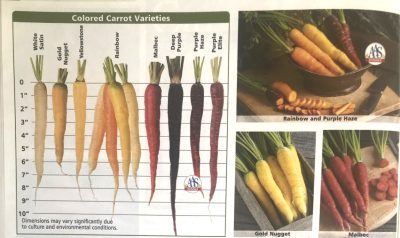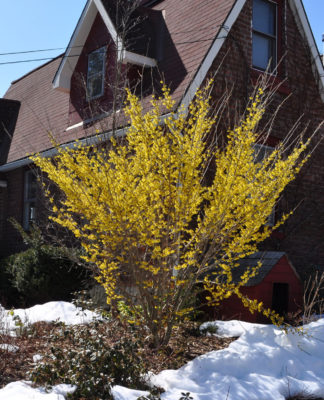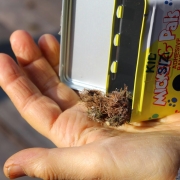Snowy Skies & Winter Colors
Snow Outside but Color Inside
A day like this, a gray sky and six inches of fluffy, fresh snow laid gently atop the white already resting on the ground, hardly turns my mind to gardening or plants. Even the greenhouse, usually a cheery horticultural retreat in winter, is dark and cold. Snow on the roof blocks what little light peeks through the gray sky, and the heater doesn’t come alive until the temperature drops to about 37° F.

Carrots from jonnyseeds.com
And then I reach into my mailbox, and out comes summer! Seed and nursery catalogs oozing with photos of fresh carrots, heads of lettuce, juicy peaches, and sunny sunflowers. I’ve already ordered all my seeds, or so I thought until I started thumbing through more catalogs. Offerings in vegetable seeds, in particular, seem to get more interesting each year.
Take carrots, for example. Carrots have long been available in all sort of shapes and sizes. Nowadays, I can also buy seeds for white carrots (White Satin variety), carrots deep purple through and through (Deep Purple variety), and purple carrots with orange centers (Purple Haze variety).
Caulifower is also getting colorful. Its curds no longer need to be only white. The variety Cheddar is the color of orange cheddar cheese. Graffiti is a purple variety, unique among purple cauliflowers for retaining its color after being cooked. Years ago, I used to grow Violet Queen cauliflower, which turns green after being cooked and tastes very good.
I’m not saying that any of these interesting varieties taste better than less flamboyant varieties. Just sayin’ . . . they’re interesting.
Which Hazel?
Besides perusing summer-y seed and nursery catalogs, another antidote for a gray winter day is to get outside and enjoy it. I’m hoping to do that today, to glide through wooded paths on cross-country skiis.
No doubt I will come across plants flaunting winter weather and showing signs of life —even on this gray day. Native witchhazels, the so-called “common witchhazel” (Hamamelis virginiana), ocacionally still are showing off some of their strappy yellow flower petals.  The flowers don’t exactly jump out at you so you have to get up pretty close to even notice them. Still, they are a sign of plant life in the depths of winter.
The flowers don’t exactly jump out at you so you have to get up pretty close to even notice them. Still, they are a sign of plant life in the depths of winter.
Common witchhazel typically begins blooming in September and finishes by December. How seemingly foolish! It’s been hypothesized that they bloom when they do so as not to compete with another species, vernal witchhazel (H. vernalis), where both are native. (This seems an unusual explanation because plant evolution is generally encouraged by cross breeding. That’s why an apple tree, for instance, can’t pollinate itself even though each of its flowers have both male and female parts; it has to cross with pollinate with a genetically different tree to make seeds and fruit.) Vernal witchhazel, at home in the midwest and south, begins blooming in January and might continue until spring.
Even without that competition, not much reproduction is going on with common witchhazel. It has a motley crew of pollinators: tiny wasps, fungus gnats, bees, flies, and winter moths. And even with all those matchmakers, less than 1% of flowers go on to form fruit and make seed. The seeds, 2 per fruit, are shot out of the fruits in autumn. After weevils, caterpillars, wild turkeys, and squirrels have had their fill, only about 15% of those few seeds survive. It’s a wonder that I come upon so many witchhazels in my winter glides and walks.
Looking over plant and garden notes from last year, I see that my cultivated witchhazel, the variety Arnold Promise, bloomed in my front yard in mid-March last year. That variety is a hybrid of Chinese and Japanese species. It blossoms later and its blossoms are much, much showier and more fragrant.
Sow Already?

Last year, sowing onion seeds
According to my notes, I’m due to plant onion seeds sometime soon. Yes, seeds. Seeds are the only way to be able to choose from the widest selection of onion varieties. Still, seeing witchhazel flowers will not be enough to well up in me an urge to plant anything. Tomorrow will be sunny; that should do it.
Update: Except that I chose the sunny day to go skiing instead. The onion seeds can wait. Growth is so slow early in the season that, come early May, there’s little difference in size among seedlings grown from seed planted now or within the next couple of weeks.



I recently picked up a copy of your book “A Northeast Gardener’s Year” and am enjoying it very much.
I planted my onion seeds this week: NY Early, Cortland, Talon F1, and Rosa di Milano. I grew Cortland last year and had success, so I decided to expand my efforts. Only Cortland is seed from last year, and some gardeners recommend buying new onion seed every year. However, your book states that onion seeds should be good for 2 years, so I am giving it a try.
Storage conditions are important in seed longevity.
Hi, Jesse here
Live in southeastern , Hamburg, Pa. Zone 6
I’am sure we all look for spring, and signs of it. Just today a saw a flock of Robins flying around. and the most encouraging I spotted In only one of many spots. A pile of Snow Drops blooming. Put a smile on my face. These little guys are so hardy some years I find them blooming as the snow melts around them. Next will be ( do not know the name of them) Will be this plants Leaves look like tiny hands with a little yellow flower on top and probably, next much latter will be the white flowers of my Blood Root plants. Spring is coming. Well back to cloning all kinds of fruit bushes my winter time hobby. Thank you for your time. Jesse
The “tiny hands with a little yellow flower” plant is, I believe, winter aconite.
Hi, Jesse here
Thanks looked it up. Right on ,Winter Aconite. Have for 5 or 6 years now, aquired by the river. Did not know what to call it.
Thank You for your time and info.
Jesse